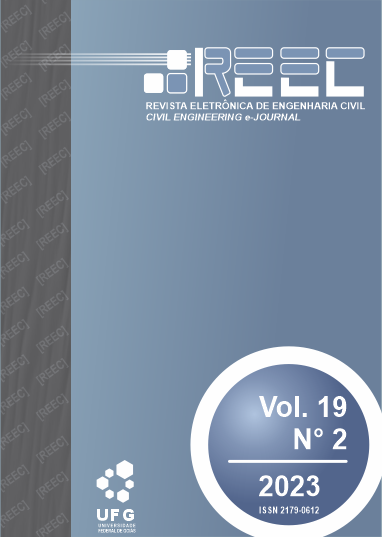MODELOS PLÁSTICOS MACROSCÓPICOS HOMOGENEIZADOS UTILIZANDO O CONCEITO DE EVR PARA MATERIAIS POROSOS
DOI:
https://doi.org/10.5216/reec.v19i2.75451Palavras-chave:
EVR, Microestrutura, Materiais Porosos, Modelos macroscópicos plásticosResumo
Este trabalho trata da obtenção de modelos constitutivos macroscópicos de materiais heterogêneos utilizando o conceito de homogeneização de Elemento de Volume Representativo (EVR) para emprego em análise de estruturas levando a análises de baixo custo computacional quando comparadas àquelas com total acoplamento entre escalas. Para tanto, estados de deformação macroscópicas são impostas ao EVR de modo a obter modelos representados por curvas tensão plástica homogeneizada versus deformação plástica imposta. Os EVrs são representativos de microestruturas de materiais porosos com matriz de comportamento dúctil. Uma técnica de homogeneização é empregada em conjunto com o modelo de von Mises. Os resultados demonstram que é possível obter modelos constitutivos para materiais complexos sem recorrer a modelos fenomenológicos complexos e com muitos parâmetros a identificar, tornando inviável a utilização em aplicações da prática da Engenharia.
Downloads
Referências
BELYTSCHKO T., LOEHNERT S., SONG J.H. Multiscale aggregating discontinuities: A method for circumventing loss of material stability. International Journal for Numerical Methods in Engineering, 73:869–894, 2008.
BENSOUSSAN, Alain; PAPANICOLAU, George; LIONS, J.-L. Asymptotic analysis for periodic structures, North-Holland Publishing , Amsterdam , 1978.
BLANCO, P.J., SÁNCHEZ, P.J., DE SOUZA NETO, E.A., FEIJÓO, R.A. Variational Foundations and Generalized Unified Theory of RVE-Based Multiscale Models. Archives of Computational Methods in Engineering, v. 23, p. 191–253, 2016.
BORGES, D. C. Estudo e avaliação de uma proposta de modelagem do comportamento micromecânico do concreto. 2015. 111f. Dissertação (Mestrado em Engenharia Civil) - Programa de Pós-Graduação em Geotecnia, Estruturas e Construção Civil – Universidade Federal de Goiás, Goiânia, 2015.
CALLISTER, W. D.; RETHWISCH, D. G. Ciência e engenharia de materiais: Uma introdução. 9. ed. Rio de Janeiro: LTC, 2018. 1014 p. ISBN 978-85-216-3236-8.
CROZARIOL, Luís Henrique de Rezende; FERNANDES, Gabriela Rezende. Analysis of the constitutive response of heterogeneousmaterials by the Boundary Element Method,considering different RVE microstructures. Matéria, [S. l.], ano 2020, v. 25, n. 1, p. 1-17, 27 ago. 2019.
FERNANDES, G. R.; SILVA, M. J. M. ; VIEIRA, J. F. ; Pituba, J.J. C . A 2D RVE formulation by the boundary element method considering phase debonding. Engineering Analysis with Boundary Elements, v. 104, p. 259-276, 2019.
GIUSTI, S. M.; BLANCO, P. J.; DE SOUZA NETO, E. A.; FEIJÓO, R. A. An assessment of the Gurson yield criterion by a computational multi-scale approach. Engineering Computations: International Journal for Computer-Aided Engineering and Software, v. 26, n.3, p. 281-301, 2009.
HAVLÁSEK, P., JIRÁSEK, M. Multiscale modeling of drying shrinkage and creep of concrete. Cement and Concrete Research, v. 85, p. 55-74, 2016.
HILL, R. A self-consistent mechanics of composite materials. Journal of the Mechanics and Physics of Solids, v. 13, n. 4, p. 213-222, 1965.
NADERI, S., ZHANG, M. Meso-scale modelling of static and dynamic tensile fracture of concrete accounting for real-shape aggregates. Cement and Concrete Composites, v. 116, 103889, 2021.
NADERI, S., TU, W., ZHANG, M. Meso-scale modelling of compressive fracture in concrete with irregularly shaped aggregates. Cement and Concrete Research, v. 140, 106317, 2021.
PERIC, D., DE SOUZA NETO, E.A., FEIJÓO, R.A., PARTOVI, M., MOLINA, A.C. On micro-to-macro transitions for multiscale analysis of heterogeneous materials: unified variational basis and finite element implementation. International Journal for Numerical Methods in Engineering, v. 87, p. 149-170, 2011.
PITUBA, J. J. C., SANTOS, W. F., RIBEIRO, G. A. , FERNANDES, G. R.. Computational homogenisation approach applied to improve mechanical properties of heterogeneous materials. Computational and Applied Mathematics, v. 40, p. 187, 2021.
REIS, F. J. P. Multi-Scale Modelling and Analysis of Heterogeneous Solids at Finite Strains. 2014. 205 f. Thesis (Doctorate of Philosophy in Mechanical Engineering) – Faculty of Engineering University of Porto, Porto, 2014.
SÁNCHEZ-PALENCIA, Enrique. Non-homogeneous media and vibration theory. Lecture Note in Physics, Springer-Verlag, v. 320, p. 57-65, 1980.
SANTOS, W. F.; FERNANDES, G. R.; PITUBA, J. J. C.. Analysis of the influence of plasticity and fracture processes on the mechanical behavior of Metal Matrix Composites microstructures. Materia 21:577-598, set. 2016. DOI https://doi.org/10.1590/S1517-707620160003.0056.
SANTOS, W. F.; PITUBA, J. J. C. Yield surfaces of material composed of porous and heterogeneous microstructures considering phase debonding. Latino American Journal of Solids and Structures. v. 14, n. 8, p. 1387-1415, 2017.
SILVA, M. J. M.; PITALUGA, C. G.; FERNANDES, G. R.; PITUBA, J. J. C. Meso-scale modeling of the compressive mechanical behavior of concrete by a RVE-based BEM formulation. Mechanics of Advanced Materials and Structures. https://doi.org/10.1080/15376494.2022.2144974, 2022.
SUN, Y., DU, C., ZHOU, C., ZHU, X., CHEN, J. Analysis of load-induced top-down cracking initiation in asphalt pavements using a two-dimensional microstructure-based multiscale finite element method. Engineering Fracture Mechanics. V. 216, 106497, 2019.
THILAKARATHNA, P.S.M., KRISTOMBU BADUGE, K.S., MENDIS, P., CHANDRATHILAKA, E.R.K., VIMONSATIT, V., LEE, H. Understanding fracture mechanism and behaviour of ultra-high strength concrete using mesoscale modelling. Engineering Fracture Mechanics, v.234, 107080, 2020.
TORO, S.; SÁNCHEZ, P. J.; BLANCO, P. J.; SOUZA NETO, E. A.; HUESPE, A. E.; FEIJÓO, R. A. Multiscale formulation for material failure accounting for cohesive cracks at the macro and micro scales. International Journal of Plasticity, v. 76, p. 75-110, 2016.
WANG, J., LI, X., JIVKOV, A.P., LI, Q.M., ENGELBERG, D.L. Interfacial transition zones in concrete meso-scale models – Balancing physical realism and computational efficiency. Construction and Building Materials, v.293, 123332, 2021.
Downloads
Publicado
Como Citar
Edição
Seção
Licença
Autores que publicam nesta revista concordam com os seguintes termos: Autores mantém os direitos autorais e concedem à revista o direito de primeira publicação, com o trabalho simultaneamente licenciado sob a Licença Creative Commons Attribution que permite o compartilhamento do trabalho com reconhecimento da autoria e publicação inicial nesta revista.
![[REEC] Revista Eletrônica de Engenharia Civil](https://revistas.ufg.br/public/journals/30/pageHeaderLogoImage_pt_BR.png)



